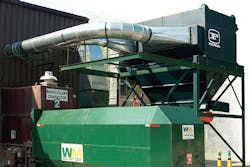OSHA silica standard compliance
The Occupational Safety and Health Administration (OSHA) hopes to save more than 600 lives per year and prevent 900 cases of silicosis with its new silica rule, which took effect in June 2016. The rule contains a standard for general industry, which requires processors and manufacturers to reduce worker exposure to crystalline silica dust and capitulate to more stringent monitoring by OSHA. This means facilities that process powder and bulk solids are now more at risk for non-compliance. This article describes the key provisions of the new rule, how processors can assess exposure risks and options for compliance using engineering controls to manage silica dust at its source.
Health risks of silica dust
Crystalline silica is found in nearly all known rocks, so it is one of Earth’s most abundant materials. Quartz, the most common form of silica, is a component of sand, stone, rock, concrete, brick, block and mortar. Occupational exposure to respirable crystalline silica occurs when workers cut, saw, drill, crush or process these materials, so it is present in a wide range of industrial processes including foundry production, abrasive blasting, shipbuilding and hydraulic fracturing. It also is released when producing products such as:
- Cement, asphalt, stone and concrete
- Pottery and structural clay
- Electronics
- Abrasives, paints, soaps and glass
- Food and beverages
Given silica’s abundance in nature, the mineral can exist even if a manufacturing operation does not use the above processes or products. And if it exists in your facility, workers can be exposed to serious health risks when the particles become airborne and inhaled.
Respirable crystalline silica causes silicosis, a progressive, incurable and often fatal lung disease. It is classified as a human carcinogen, that causes lung cancer. Silica particles of 10 microns (m) and less are small enough to enter the lungs. The tiny silica particles have jagged edges that embed in the lungs and do not dissolve.
Over time, the body creates scar tissue over the lung tissue, “entombing” the particles in the lungs. Layers of silica and scar tissue can build up over years of exposure, reducing lung function and causing difficulty breathing, fatigue, appetite loss, chest pain and respiratory failure. Silica exposure is also linked to an increased risk of lung cancer, tuberculosis, chronic obstructive pulmonary disease and kidney disease. Since there is no cure, the only weapon against silicosis is preventing it in the first place by minimizing worker’s exposure.
Key requirements of the new rule
OSHA’s new silica rule reduces worker exposure, recommends engineering controls, requires a documented control plan and calls for ongoing medical evaluation for some workers.
50 microgram (μg) exposure limit: OSHA reduced the Permissible Exposure Limit (PEL) for respirable crystalline silica to 50 μg per cubic meter (μg/m3) of air, averaged over an 8-hour, time-weighted average (TWA) work shift. This limit is twice as strict as the previous threshold limit of 100 μg/m3 of air for general industry.
Mandatory engineering controls: Employers must use engineering controls to keep the dust down and/ or capture airborne particulates as well as keep worker exposure below the 50 μm PEL. These controls can include water spray systems and/or dust collection (ventilation) systems. When engineering controls are not able to limit exposures to the permissible level, employers must provide personal respiratory protection.
Exposure control plan: Employers must produce a written exposure control plan that documents how they will achieve compliance. The plan should include training workers on silica risks and basic safety practices so they can recognize how to limit their own exposure. It should also limit access to high-exposure areas.
Medical observation: Employees are identified as "highly exposed workers" if they are exposed to more than 25 μg/m3 in an 8-hour TWA for more than 30 days per year. These employees are required to have regular medical exams and lung health monitoring, and the company must keep records to document these exams.
The compliance deadline for companies to implement engineering controls and other requirements set forth in the new standard is June 23, 2018.
Determining compliance
To reiterate, the only way to prevent workers from developing silicosis is to minimize their exposure. Therefore, the first step for a responsible employer is to determine whether silica is present in the facility.
A good starting point is the Material Safety Data Sheets (MSDS) for the materials being used in the facilities. A standard MSDS will list hazardous ingredients in Section 2. The dust might be identified as crystalline silica, silicon dioxide, quartz, cristobalite or tridymite. Silicon carbide and fly ash are examples of substances that might contain respirable silica.
Next, evaluate the processes used in the facility. OSHA requires air monitoring to be performed to determine each worker’s eight-hour TWA exposure wherever there is a process that generates crystalline silica dust. OSHA lists different accepted methods of monitoring in Appendix A of the ruling.
Why dust collection?
OSHA general provisions state, “The first and best strategy is to control the hazard at its source. Engineering controls do this, unlike other controls that generally focus on the employee exposed to the hazard.” However, not all hazards can be removed completely, so the next step is to isolate the hazards from the workplace by establishing barriers or local ventilation.
A highly engineered dust collector is a proven engineering control to filter hazardous contaminants from indoor facilities, making the air safe to breathe. The best way to capture respirable particulates is by using a dry media dust collector with high-efficiency cartridge filters and HEPA secondary filters. This form of engineering control ensures particulates will not spread and be inhaled by workers in other areas of the plant.
The new OSHA crystalline silica 50-g PEL is often achievable using this technology alone. In fact, cartridge dust collectors with secondary HEPA filters effectively control hazardous dusts with PEL limits of 5 g – or 10 times lower than the OSHA limit.
Questions to ask when designing a dust collector
Dust collectors are typically designed or configured for each specific location based on the application, type of dust and other environmental factors. Source capture using some form of hood or enclosure is the most effective control for process dust emissions. With source capture, dust is captured as soon as it is created, so it never has the chance to become airborne, and negative air pressure is maintained on the enclosures to keep the dust contained.
When designing a dust collection system for crystalline silica dust control, it is ideal to test dust samples in a lab to identify the properties of the dust including particle size, shape and moisture content. The following are some design considerations.
1. What size are the dust particles?
Filter media efficiency is based on dust particle size and distribution. A standard cellulose-polyester-blend cartridge filtration media can be effective enough for particles larger than 1.0 m but not for smaller particles. If very fine, submicron particles are present, a high-efficiency nanofiber media works effectively. A layer of nanofibers is applied on top of the base filter media, forming a coating that promotes surface loading of fine dust. This prevents the fine dust from penetrating deeply into the base media, which reduces emissions.
2. What shape are the dust particles?
Silica dust is very abrasive because of the particles’ sharp, jagged edges. For this reason, dust collection systems must be designed with maximum abrasion resistance. If not, there will be constant wear and tear on components, and holes will develop in the filter media, creating a leak path for harmful dust to escape into the workplace. One way to resist abrasion is to make sure the dust collector has an air inlet designed for slow and uniform distribution of airflow. This prevents abrasive particles from entering the system at high velocity. Secondary HEPA filters further protect the facility by trapping the very fine particulate emissions that may pass through the primary filters due to wear.
3. How much moisture is in the air?
Silica dust will absorb moisture from the air and take on the characteristics of mud, which is much more difficult to collect. It also gets packed in the filter pleats, reducing filter life. However, it may be necessary for a facility to use water for cooling, lubricating or aiding a process. In these instances, a dry filter may not work, and consideration of different media is needed. Or, in the case of facilities located in a condensation-prone northern climate, the dust collector may need to be located indoors, or use of a heater and/or insulated enclosure may be necessary. If necessary precautions are not taken, water vapor will condense on all surfaces inside the collector including the filters. Once in the filters, the dust will absorb the water and cause premature filter failure.
4. Can the air be recirculated?
Recirculating the air from a dust collector back into a facility results in substantial savings in energy costs and maximizes the dust collector’s return on investment. When heated or cooled air is recirculated back through the building, it reduces the need for costly make-up air required when venting the air outdoors. Facilities in northern climates save the most, but facilities in all regions report five- to six-figure annual energy savings. To recirculate the air, use of a secondary filter to prevent dust from re-entering the facility is necessary. Secondary filters may be remotely mounted using ducts between the two filtration stages, but it can be costly and time-consuming to clean out long ducts if an upset condition occurs. This is why newer designs integrate HEPA filters within or on top of the dust collector to prevent the return-air ducting from contamination.
5. Should filters be mounted horizontally or vertically?
Some dust collectors have filter cartridges mounted horizontally and others vertically. With horizontally mounted systems, heavy, high-density dust-like silica builds up atop filters and is not dislodged by pulse cleaning. Rotating the filters periodically helps dislodge dust but also increases employee exposure to silica dust. Vertical mounting allows silica dust to release uniformly from the filter pleats, since it does not have to fight gravity. This reduces the load on the filters, helps extend filter life and reduces workers’ exposure since the filter compartment must only be opened when it is time to replace the filters.
Maintaining efficiency & safety
Even the longest-lasting filters need to be replaced eventually to ensure dust is effectively controlled. These will need replacing as soon as the differential pressure through the system reaches the maximum level specified by the filter manufacturer. It is also important to train maintenance personnel in proper service procedures.
Prior to change out, filters should be pulsed down to remove as much dust as possible, and the access door should not be opened until the dust has had time to settle. Used filters should be placed immediately in the same boxes the new filters were shipped in, sealed to prevent dust from escaping and disposed of as non-hazardous waste. Then new filters can be placed, and the system should be closed up as quickly as possible.
It is also important to empty the dust collector’s waste storage container regularly to prevent dust from backing up into the hopper and clogging the system. Dust overflow, particularly when it contains hazardous materials like silicates, creates a potential health hazard to everyone in the workspace.
OSHA’s general housekeeping practices also recommend avoiding the use of brooms or compressed air systems capable of dispersing dust particles into the atmosphere. A water spray (to keep dust down) and/or a vacuum cleaner (to remove excess dust from floors and other surfaces before they become airborne) should be used instead.
By understanding key provisions of OSHA’s new silica dust rule and learning about engineering controls such as dust collectors that control silica dust at its source, powder processors protect themselves from non-compliance penalties. But more importantly, processors ensure they are doing everything possible to promote their workers’ continued health and wellness.
References
Occupational Safety & Health Administration (OSHA), http://www.osha.gov:
- OSHA 29 CFR Parts 1910, 1915 and 1926. Occupational Exposure to Respirable Crystalline Silica. Final Rule (2016).
- Crystalline Silica Exposure in General Industry (Health hazard training document).
- Occupational Exposure to Respirable Crystalline Silica: Review of Health Effects Literature and Preliminary Quantitative Risk Assessment. Docket OSHA-2010-0034.
- Safety & Health Management Systems eTool: Hazard Prevention and Control.
Mike Walters, PE, is the senior engineer for Camfil Air Pollution Control (APC) and is a principal for the National Fire Protection Association committee: "Handling and Conveying of Dusts, Vapors, and Gases (CMD-HAP)."
Alex Wells is a lab engineer for Camfil APC, a global manufacturer of dust-, mist- and fume-collection equipment, which is part of Camfil, the largest air filter manufacturer in the world. For further information, call 1-800-479-6801 or 1-870-933-8048, or email [email protected].




